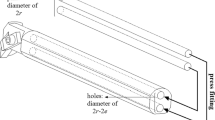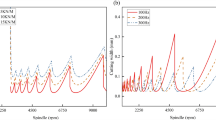Abstract
Purpose
Slender boring bars vibrate when excited by cutting forces to result in chatter. These chatter vibrations damage the part and the tool and hence must be avoided and/or suppressed. Usually, tuned absorbers integrated within the boring bar dissipate the motion of the boring bar and make stable cutting possible. However, since the boring bar’s dynamics change with loading and boundary conditions, optimally tuning the absorber becomes difficult. This prevents stable high-performance cutting. To improve the cutting performance of a potentially detuned absorber within a boring bar, this paper presents a novel hybrid damping solution. The hybrid damper is composed of an absorber working in conjunction with an eddy current damper.
Methods
To demonstrate the working of this hybrid damper, we model the boring bar as an Euler–Bernoulli beam. A permanent magnet is supported by a spring and damper within a copper section of a boring bar. The supported magnet acts as an absorber and the relative motion between the conductive copper bar and the magnetic field induces eddy currents that hinder the motion of the boring bar. Governing equations for the beam with an integrated damper are obtained by applying the extended Hamilton’s principle. Eddy current damping is evaluated by applying the Lorentz force law and the Biot–Savart law.
Results
Our analysis suggests that the improvement in the chatter-free depth of cut with a hybrid damper over the case with a detuned absorber is as much as ~ 500%. And, when the absorber is optimally tuned and the hybrid damper takes its maximum possible value, the chatter-free depth of cut for both cases was found to be the same, suggesting that if/when the absorber can be optimally tuned, the eddy current damper offers no additional benefit.
Conclusion
Since optimally tuning an absorber is difficult, our proposed hybrid damper offers a feasible solution to improve cutting performance with slender boring bars. Moreover, since our models are generalized, the approach may also be used to explore the integration of such hybrid dampers within other tooling systems such as milling tool holders.







Similar content being viewed by others
References
Munoa J, Beudaert X, Dombovari Z, Altintas Y, Budak E, Brecher C (2016) Chatter suppression techniques in the metal cutting. CIRP Ann Manuf Technol 65:785–808. https://doi.org/10.1016/j.cirp.2016.06.004
Den Hartog JP (1985) Mechanical vibrations. Dover Publications, New York, USA
Asami T, Nishihara O, Baz AM (2002) Analytical solutions to h∞ and h2 optimization of dynamic vibration absorbers attached to damped linear systems. J Vib Acoust Trans ASME 124(2):284–295. https://doi.org/10.1115/1.1456458
Sims ND (2007) Vibration absorbers for chatter suppression: a new analytical tuning methodology. J Sound Vib 301:592–607. https://doi.org/10.1016/j.jsv.2006.10.020
Tlusty G (2000) Manufacturing equipment and processes. Prentice-Hall, Upper Saddle River
Miguélez MH, Rubio L, Loya JA, Fernández-Sáez J (2010) Improvement of chatter stability in boring operations with passive vibration absorbers. Int J Mech Sci 52(10):1376–1384. https://doi.org/10.1016/j.ijmecsci.2010.07.003
Rubio L, Loya JA, Miguélez MH, Fernández-Sáez J (2013) Optimization of passive vibration absorbers to reduce chatter in boring. Mech Syst Signal Process 41(1–2):691–704. https://doi.org/10.1016/j.ymssp.2013.07.019
Yadav A, Talaviya D, Bansal A, Law M (2020) Design of chatter-resistant damped boring bars using a receptance coupling approach. J Manuf Mater Process. https://doi.org/10.3390/jmmp4020053
Rivin EI, Kang H (1992) Enhancement of dynamic stability of cantilever tooling structures. Int J Mach Tools Manuf 32(4):539–561. https://doi.org/10.1016/0890-6955(92)90044-H
Akesson H, Smirnova T, Hakansson L (2009) Analysis of dynamic properties of boring bars concerning different clamping conditions. Mech Syst Signal Process 23:2629–2647. https://doi.org/10.1016/j.ymssp.2009.05.012
Altintas Y, Lappin D, Van Zyl D, Östling D (2021) Automatically tuned boring bar system, CIRP Annals, 70(1). ISSN 313–316:0007–8506. https://doi.org/10.1016/j.cirp.2021.04.058
Thekkepat AA, Devadula S, Law M (2021) Identifying joint dynamics in bolted cantilevered systems under varying tightening torques and torsional excitations. J Vib Eng Technol. https://doi.org/10.1007/s42417-021-00386-8
Patel A, Talaviya D, Law M, Wahi P (2022) Optimally tuning an absorber for a chatter-resistant rotating slender milling tool holder. J Sound Vib 520:116594. https://doi.org/10.1016/j.jsv.2021.116594
Yang Y, Wang Y, Liu Q (2019) Design of a milling cutter with large length–diameter ratio based on embedded passive damper, JVC/Journal Vib. Control 25:506–516. https://doi.org/10.1177/1077546318786594
Sodano HA, Bae J (2004) Eddy current damping in structures. Shock Vib Dig 36(6):469–478. https://doi.org/10.1177/0583102404048517
Paul P, Ingale C, Bhattacharya B (2014) Design of a vibration isolation system using eddy current damper. Proc Inst Mech Eng Part C J Mech Eng Sci 228(4):664–675. https://doi.org/10.1177/2F0954406213489408
Bae JS, Kwak MK, Inman DJ (2005) Vibration suppression of a cantilever beam using eddy current damper. J Sound Vib 284(3–5):805–824. https://doi.org/10.1016/j.jsv.2004.07.031
Sodano HA, Bae J, Inman DJ, Belvin W (2005) Concept and model of eddy current damper for vibration suppression of a beam. J Sound Vib 288(4–5):1177–1196. https://doi.org/10.1016/j.jsv.2005.01.016
Sodano HA, Bae J, Inman DJ, Belvin W (2006) Modeling and application of Eddy current damper for suppression of membrane vibrations. AIAA J 44(3):541–549. https://doi.org/10.2514/1.13024
Sodano HA, Bae J, Inman DJ, Belvin W (2006) Improved concept and model of Eddy current damper. J Vib Acoust Trans ASME 128(3):294–302. https://doi.org/10.1115/1.2172256
Yang Y, Xu D, Liu Q (2015) Milling vibration attenuation by Eddy current damping. Int J Adv Manuf Technol 81(1–4):445–454. https://doi.org/10.1007/s00170-015-7239-3
Chen F, Zhao H, Ding H (2018) Eddy current damper design for vibration suppression in robotic milling process. Proc IEEE Int Conf Robot Autom. https://doi.org/10.1109/ICRA.2018.8460693
Singh R, Deiab IM (2019) Non-contact auxiliary fixture for machining stability improvement of thin flexible workpieces using Eddy currents. Int J Interact Des Manuf 13(2):423–440. https://doi.org/10.1007/s12008-018-0495-3
Munoa J, Sanz-Calle M, Dombovari Z, Iglesias A, Pena-Barrio J, Stepan G (2020) Tuneable clamping table for chatter avoidance in thin-walled part milling. CIRP Ann 69(1):313–316. https://doi.org/10.1016/j.cirp.2020.04.081
Bae JS, Hwang JH, Roh JH, Kim JH, Yi MS, Lim JH (2012) Vibration suppression of a cantilever beam using magnetically tuned-mass-damper. J Sound Vib 331(26):5669–5684. https://doi.org/10.1016/j.jsv.2012.07.020
Chen J, Lu G, Li Y, Wang T, Wang W, Song G (2017) Experimental study on robustness of an eddy current-tuned mass damper. Appl Sci 7:895. https://doi.org/10.3390/app7090895
Bae JS, Park JS, Hwang JH, Roh JH, Do PB, Kim JH (2018) Vibration suppression of a cantilever plate using magnetically multimode tuned mass dampers. Shock Vib. https://doi.org/10.1155/2018/3463528
Beek TA, Pluk KJW, Jansen JW, Lomonova EA (2014) Optimization and measurement of eddy current damping applied in a tuned mass damper. Int Conf Electr Mach. https://doi.org/10.1109/ICELMACH.2014.6960243
Berardengo M, Cigada A, Guanziroli F, Manzoni S (2015) Modelling and control of an adaptive tuned mass damper based on shape memory alloys and eddy currents. J Sound Vib 349:18–38. https://doi.org/10.1016/j.jsv.2015.03.036
Lian J, Zhao Y, Lian C, Wang H, Dong X, Jiang Q, Zhou H, Jiang J (2018) Application of an eddy current-tuned mass damper to vibration mitigation of offshore wind turbines. Energies. https://doi.org/10.3390/en11123319
Bae JS, Hwang JH, Kwag DG, Park J, Inman DJ (2014) Vibration suppression of a large beam structure using tuned mass damper and eddy current damping. Shock Vib. https://doi.org/10.1155/2014/893914
Lazoglu I, Atabey F, Altintas Y (2002) Dynamics of boring processes: part III-time domain modeling. Int J Mach Tools Manuf 42:1567–1576. https://doi.org/10.1016/S0890-6955(02)00067-6
Hagedorn P, DasGupta A (2007) Vibrations and waves in continuous mechanical systems. John Wiley & Sons Ltd, New Jersey
Craik D (1995) Magnetism: principles and applications. John Wiley & Sons Ltd, New Jersy
https://radialmagnet.com/. Accessed on 01 Apr 2022
Dem’yanov V F, Malozemov V N (1990) Introduction to minimax, courier corporation, USA.
Acknowledgements
This work was supported by the Government of India’s Impacting Research Innovation and Technology (IMPRINT) initiative through project number IMPRINT 5509.
Funding
Impacting Research Innovation and Technology, 5509, Mohit Law
Author information
Authors and Affiliations
Corresponding author
Ethics declarations
Conflict of interest
On behalf of all authors, the corresponding author states that there is no conflict of interest.
Additional information
Publisher's Note
Springer Nature remains neutral with regard to jurisdictional claims in published maps and institutional affiliations.
Rights and permissions
Springer Nature or its licensor holds exclusive rights to this article under a publishing agreement with the author(s) or other rightsholder(s); author self-archiving of the accepted manuscript version of this article is solely governed by the terms of such publishing agreement and applicable law.
About this article
Cite this article
Patel, A., Yadav, A., Law, M. et al. Damped Chatter Resistant Boring Bar Integrated with an Absorber Working in Conjunction with an Eddy Current Damper. J. Vib. Eng. Technol. 11, 2013–2024 (2023). https://doi.org/10.1007/s42417-022-00684-9
Received:
Revised:
Accepted:
Published:
Issue Date:
DOI: https://doi.org/10.1007/s42417-022-00684-9




